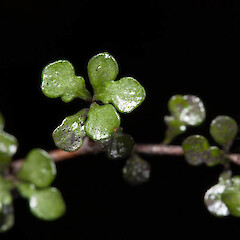Pittosporum turneri
Common name
Turner’s kōhūhū, tent pole tree
Synonyms
None
Family
Pittosporaceae
Flora category
Vascular – Native
Endemic taxon
Yes
Endemic genus
No
Endemic family
No
Structural class
Trees & Shrubs - Dicotyledons
Chromosome number
2n = 24
Current conservation status
The conservation status of all known New Zealand vascular plant taxa at the rank of species and below were reassessed in 2017 using the New Zealand Threat Classification System (NZTCS) – more information about this can be found on the NZTCS website. This report includes a statistical summary and brief notes on changes since 2012 and replaces all previous NZTCS lists for vascular plants.
Please note, threat classifications are often suggested by authors when publications fall between NZTCS assessment periods – an interim threat classification status has not been assessed by the NZTCS panel.
- Conservation status of New Zealand indigenous vascular plants, 2017 . 2018. Peter J. de Lange, Jeremy R. Rolfe, John W. Barkla, Shannel P. Courtney, Paul D. Champion, Leon R. Perrie, Sarah M. Beadel, Kerry A. Ford, Ilse Breitwieser, Ines Schönberger, Rowan Hindmarsh-Walls, Peter B. Heenan and Kate Ladley. Department of Conservation. Source: NZTCS and licensed by DOC for reuse under the Creative Commons Attribution 4.0 International licence.
2017 | Threatened – Nationally Vulnerable | Qualifiers: CD, PD, RF
Previous conservation statuses
2012 | Threatened – Nationally Vulnerable | Qualifiers: CD, Inc, PD
2009 | Threatened – Nationally Vulnerable | Qualifiers: CD, Inc, PD
2004 | Threatened – Nationally Endangered
Brief description
Rare small tree that goes through a column-shaped wide-angled juvenile form bearing a variety of small uneven often glossy leaves before becoming a normally-branched tree with 3-5cm long thick leathery leaves that are widest towards the tip. Twigs of juveniles bulge at junction. Capsule 7-10mm wide and splits into two.
Distribution
Endemic. Confined to the central North Island, from southern Pureora to the Ruahine Range. Formerly present near Otorohanga.
Habitat
A montane to subalpine small tree of forest/frost flat margins and grey scrub developed alongside streams.
Detailed description
Gynodioecious, small tree up to 8 m tall. Growth form columnar, juveniles and sub adults distinctly divaricating. Branches and branchlets of seedlings and saplings up to 1 m tall, sparse, spreading, divaricating, more or less interlacing and filiramulate; sub adult branches and branchlets, numerous, strongly divaricating, hexagonally interlacing and filiramulate; adult branches erect to shortly spreading, more or less fastigiated, weakly divaricating, non-filiramulate. Seedling leaves 5-20 x 2-4 mm, linear, deeply lobed or coarsely toothed, sometimes pinnatifid to lyrate-pinnatifid, bronze-green, red-green to cream or grey-green, often blemished with darker tones of red or brown. Sub adult leaves, firmly fleshy to coriaceous, 3-10 x 2-6 mm, red-green, cream, bronze-green, often flushed pink or maroon, linear to lanceolate, sometimes obovate or narrow-obovate, usually irregularly lobed, toothed or pinnatifid; these forms gradually giving way to adult foliage toward top of tree. Adult leaves rather coriaceous. Petioles stout, 1-2 mm long, fleshy. Leaf lamina 30-60 x 5-10 mm, dark green, green, often flushed with red; oblanceolate, obovate to narrowly obovate, clavate to linear-lanceolate, base cuneate to attenuate, apex obtuse to subacute, margins entire to weakly lobulate. Flowers in terminal 4-10-15-flowered umbels. Pedicels 10-15 mm long. Flowers night-fragrant. Sepals 5, 3-6 mm long, ovate-lanceolate, acute, pale green, sparsely pilose hairy. Petals 5, 8-10 mm, lanceolate, apex obtuse, recurving almost to base at anthesis, pink, red-pink, margins often darker than central portion; sometimes completely white. Male flowers with 5 functional stamens and one rudimentary or functional stigma, anthers yellow. Female flowers with 5 rudimentary stamen, stigma globose. Capsules subglobose, 7-10 mm diameter, 2-valved, valves weakly woody to woody, initially dark green maturing grey-black. Mucilage dark red. Seeds 5-8, globose to irregularly globose, black, surface glossy.
Similar taxa
Juvenile specimens of pokaka (Elaeocarpus hookerianus) can look rather similar because of their narrowly, erect, columnar growth habit and divaricating branches. However, pokaka branchlets lack the distinctive hexagonal branching pattern typical of Pittosporum turneri. Also juvenile pokaka leaves are more numerous, larger, more variable, usually heavily lobed, and the linear variations of this species are more deeply serrated.
Flowering
October to December.
Flower colours
Green, Red/Pink
Fruiting
January - March.
Propagation technique
Easy from fresh seed, which germinates within 6-12 months. An interesting specimen tree that is easily grown in a range of conditions, but does best in cooler climates, on free draining but moist soils. Specimens many take 10-15 years to reach adult stage
Threats
The adult foliage of Pittosporum turneri is a favourite of possums and it is suspected that saplings are eaten by deer and goats. Several historic sites were eliminated due to land development for grazing and forestry. At most sites the species is vulnerable to weed invasion, a constant problem as the habitat P. turneri usually occupies requires frequent disturbance to maintain itself. Because of this requirement the species is also vulnerable to habitat loss through natural succession as vegetation matures. Some populations exhibit skewed sex ratios, others lack adult specimens, while others have hybridism issues with P. divaricatum Cockayne.
Etymology
pittosporum: Pitch seed
Where To Buy
Not commercially available.
Notes on its status
Pittosporum turneri is a conservation anomaly. There are believed to be 30,000-50,000 plants in the wild. However, fewer than 400 of these are adults. Which is why this abundant species remains seriously threatened.
Attribution
Fact sheet prepared by P.J. de Lange 30 August 2004. Description from de Lange et al. (2010).
References and further reading
de Lange, P.J.; Heenan, P.B.; Norton, D.A.; Rolfe, J.R.; Sawyer, J.W.D. 2010: Threatened Plants of New Zealand, Christchurch, Canterbury University Press.
Rogers, G. 1988. Parentless Pittosporum turneri. Wellington Botanical Society Bulletin, 44: 26-36
NZPCN Fact Sheet citation
Please cite as: de Lange, P.J. (Year at time of access): Pittosporum turneri Fact Sheet (content continuously updated). New Zealand Plant Conservation Network. https://www.nzpcn.org.nz/flora/species/pittosporum-turneri/ (Date website was queried)
















